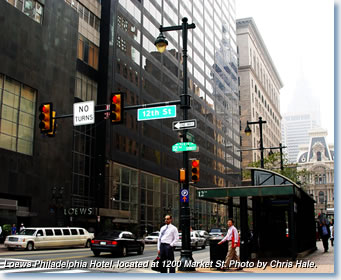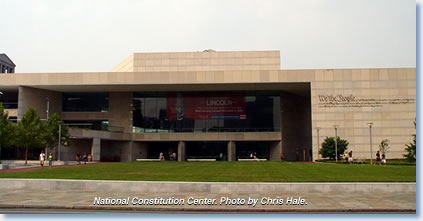 This article is intended to get you out of the hotels and onto the streets for some uniquely Philadelphia experiences. Before you leave the Loews Philadelphia, however, take a good look. Designed by George Howe and William Lascaze with Walter Behrmon interiors (1929–32), this building introduced the international style to America. The 27-foot neon PSFS sign on the roof stands for Philadelphia Saving Fund Society. Loews retained the sign after it purchased the mutual savings bank's headquarters building, recognizing that this early use of neon in architecture was integral to the National Historic Landmark.
This article is intended to get you out of the hotels and onto the streets for some uniquely Philadelphia experiences. Before you leave the Loews Philadelphia, however, take a good look. Designed by George Howe and William Lascaze with Walter Behrmon interiors (1929–32), this building introduced the international style to America. The 27-foot neon PSFS sign on the roof stands for Philadelphia Saving Fund Society. Loews retained the sign after it purchased the mutual savings bank's headquarters building, recognizing that this early use of neon in architecture was integral to the National Historic Landmark.
One block west of Loews, Lord and Taylor is located in the former John Wanamaker Department Store (1902–10). Architect John Burnham designed this imposing consumers' palace on a former freight depot. Wanamaker utilized existing rail tracks to bring goods directly into his stock rooms. In its heyday, Wanamaker's offered one-stop shopping, supplying everything from watch and fountain pen repairs to furnishings for an entire household. Today, Lord and Taylor occupies the lower floors of the building. Visitors are welcome to explore the five-story interior center court housing a pipe organ from the 1904 Louisiana Purchase Exposition. Concerts are still offered, usually during prime shopping seasons. August Gaul's six-and-a-half-foot bronze eagle, also from the exposition, stands in the court and is a traditional meeting place for shoppers. A statue of Wanamaker is on the east apron of Philadelphia's City Hall where the retailing pioneer watches over his store.
 From Lord and Taylor, walk one block north and one west to the Philadelphia Masonic Temple, Broad and Filbert Streets. James H. Windrim designed the building (1868–73) as a celebration of notable masonry achievements. Spain's Alhambra inspired the Oriental Hall, for instance. There is also an Egyptian Room, a Norman Hall, and a museum and research library. Tours are offered Tuesday–Saturday for a small donation. Call 215-988-1917 to verify hours.
From Lord and Taylor, walk one block north and one west to the Philadelphia Masonic Temple, Broad and Filbert Streets. James H. Windrim designed the building (1868–73) as a celebration of notable masonry achievements. Spain's Alhambra inspired the Oriental Hall, for instance. There is also an Egyptian Room, a Norman Hall, and a museum and research library. Tours are offered Tuesday–Saturday for a small donation. Call 215-988-1917 to verify hours.
The Reading Terminal, the former head house of the Reading Railroad, is across the street from Loews Philadelphia at 12th and Market Streets. Wilson Brothers designed the pink and white Renaissance revival building, which opened as a rail terminal in 1893. Today, it is preserved as part of the Pennsylvania Convention Center. Enter the building to see the surviving single-span train shed; and stop in the Independence Brew Pub, a local micro brewery, for great beer and ale. A Hard Rock Café with a rotating, neon-trimmed guitar over its entrance is also housed in the terminal. The Reading Terminal Market, with its 80 vendors, is located just north of Market Street.
If you walk east on Market Street toward the Delaware River, there are several places to explore. At 10th Street, look north and see the Chinese Friendship Gate, the official entrance to Chinatown. Continue on Market Street to 7th. At Arch Street one block north of Market is the African American Museum, offering permanent and traveling exhibitions about African American history and culture (215-574-0380). There is a gift shop and an extensive program of special events.
On South Seventh Street between Market and Chestnut, you can visit the Atwater Kent Museum (AKM), (215-685-4830). Philadelphia's official history museum uses its collections to trace the city's 324-year story. AKM is the keeper of the city's archeological collection as well as the non-print and manuscript materials of the Historical Society of Pennsylvania. The gift shop has a great selection of scholarly books on local topics.
As you leave AKM, stop at the vendor across the street. He is one of a long tradition of pushkartniks who plied their wares around town. In January, his cart has an impressive inventory of socks, scarves, hats, gloves, and mittens for a designer look at bargain prices. A few doors south of the vendor, stop at Lore's Chocolates, a family-owned confectionary (215-627-3233). Here, candies are elegantly displayed on polished wooden tables. You owe yourself a peek inside where you can stock up on one of the essential food groups. Next door, warm up with hot chocolate or gourmet coffee.
 The Independence Visitor Center is on the northeast corner of 6th and Market Streets. This is a regional visitor center and also the gateway to Independence National Historical Park (800-537-7676). You can obtain information here about recreational activities throughout the Delaware Valley as well as about National Park Service resources in the area, including Independence Hall and the Liberty Bell. Don't miss Congress Hall, the site of the first peaceful transfer of power in the western world; Franklin Court, where Ben's 300th birthday celebration is underway; the public archeology lab in the Independence Living History Center; or the portrait collection in the Second Bank of the United States. Check www.nps.gov.inde for special programs during your visit. The National Constitution Center (NCC) on Arch Street between 5th and 6th at the north end of Independence Mall features exhibits on the United States Constitution (215-923-0004). NCC is also currently hosting the major traveling show for the Benjamin Franklin Tercentenary.
The Independence Visitor Center is on the northeast corner of 6th and Market Streets. This is a regional visitor center and also the gateway to Independence National Historical Park (800-537-7676). You can obtain information here about recreational activities throughout the Delaware Valley as well as about National Park Service resources in the area, including Independence Hall and the Liberty Bell. Don't miss Congress Hall, the site of the first peaceful transfer of power in the western world; Franklin Court, where Ben's 300th birthday celebration is underway; the public archeology lab in the Independence Living History Center; or the portrait collection in the Second Bank of the United States. Check www.nps.gov.inde for special programs during your visit. The National Constitution Center (NCC) on Arch Street between 5th and 6th at the north end of Independence Mall features exhibits on the United States Constitution (215-923-0004). NCC is also currently hosting the major traveling show for the Benjamin Franklin Tercentenary.
The Federal Reserve Bank at 6th and Arch Streets offers an exhibit about its role in the federal financial system. Directly across the mall on 5th Street, you can purchase coin sets and see them made at the United States Mint (215-408-0114). One block south of the mint, the National Museum of American Jewish History offers exhibitions and programs about Jewish people in America (215-923-3811).
Walk east to 116 Market Street for refreshments. The Franklin Fountain just east of 2nd Street is an old-fashioned ice cream parlor (215-627-1899). Shane's Candies, in the same block, is another multi-generational confectionary with an original late 19th century interior (215-922-1048). If it's late in the day and you need something stronger to fuel your trip back to the hotel, try the Continental Martini Bar at 2nd and Market Streets. Sit in the booths at the streamlined steel, pre-World War II diner and feel like the Thin Man or Mrs. Charles sipping a perfect martini, or try one of the bar's more recent and adventurous blends (215-923-6069).
Within five minute's walk north on 2nd Street are Elfreth's Alley, a historic residential street and museum (215-574-0560 ), Christ Church (Episcopal), and Fireman's Hall, a museum of the history of firefighting in Philadelphia located in a 1902 fire house.
Much of the excitement in Philadelphia is on the street itself. Stop at the many street vendors of food and clothing. Try your luck with a lottery ticket from the newsstands. They also carry a wide range of US and foreign-language newspapers. Enjoy a concert by a street musician. East Chestnut Street, West Walnut Street, around City Hall, and Filbert Street under the connecting arch between Reading Terminal's head house and market are great places to find good music. The shops on South 11th Street between Market and Chestnut Streets have reasonably priced clothes, dollar stores, action videos, CDs, health and beauty products, gold jewelry, and lamé purses.
Don't let bad weather prevent you from exploring the city. There is a below-ground concourse from City Hall to Walnut Street. Another concourse filled with shops is beneath Suburban Station at 15th and Market Streets. You can walk from 12th to 7th and Market Streets beneath the SEPTA train station and through the Gallery shopping mall. Busses and a subway running along Market Street will bring you reasonably close to any of the sites noted in this article. Enjoy your visit.
—Doris Devine Fanelli is chief of the Division of Cultural Resources Management in Independence National Historical Park and a member of the Local Arrangements Committee.
Tags: Annual Meeting
Comment
Please read our commenting and letters policy before submitting.






